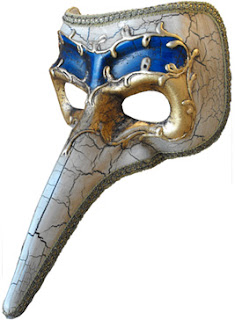I always find Ventian Masks interesting to look at, they are fabulous and mysterious. They must have a lot of story behind the appearance. I've included this in my Sketchbook 1, but here is some information about VM I collected from internet, they are really amazing.
____________________________________________________________________________________
Venetian masks are a centuries-old tradition of Venice, Italy. The masks are typically worn during the Carnevale (Carnival of Venice), but have been used on many other occasions in the past, usually as a device for hiding the wearer's identity and social status. The mask would permit the wearer to act more freely in cases where he or she wanted to interact with other members of the society outside the bounds of identity and everyday convention. It was thus useful for a variety of purposes, some of them illicit or criminal, others just personal, such as romantic encounters.
Venetian masks are characterised by their ornate design, featuring bright colours such as gold or silver and the use of complex decorations in the baroque style. Many designs of Venetian masks stem from Commedia dell'arte. They can be full-face masks (e.g. the bauta) or eye masks (e.g. the Columbina).
History
Near the end of the Republic, the wearing of masks in daily life was severely restricted. By the 18th century, it was limited only to about three months from December 26. The masks were traditionally worn with decorative beads matching in color.
Types of masks
BautaBauta is a mask which covers the whole face, this was a traditional piece of art, with a stubborn chin line, no mouth, and lots of gilding. The mask has a square jaw line often pointed and tilted upwards to enable the wearer to talk, eat and drink easily without having to remove the mask thereby preserving their anonymity. The Bauta was often accompanied by a black cape and a tricorn.
In 18th century, the Bauta had become a standardized society mask and disguise regulated by the Venetian government. It was obligatory to wear it at certain political decision-making events when all citizens were required to act anonymously as peers. Only citizens had the right to use the Bauta. Its role was similar to the anonymizing processes invented to guarantee general, direct, free, equal and secret ballots in modern democracies.
It was not allowed to wear weapons along with the mask, and police had the right to enforce this ruling.
Columbina
The Columbina (also known as Columbine and Columbino) is a half mask often highly decorated with gold, silver, crystals and feathers. It is held up to the face by a baton or tied with ribbon as with most other Venetian masks. The columbine was popularised by an early actress in the Commedia dell'arte of the same name. It is said it was designed for her because she did not wish to have her beautiful face covered completely.
Medico Della Peste (The Plague Doctor)
The Medico Della Peste with its long beak is one of the most bizarre and recognisable of the Venetian masks. The striking design has a macabre history originating from 16th century French physician Charles de Lorme who adopted the mask together with other peculiar sanitary precautions while treating plague victims. Traditionally the full face mask is white consisting of a hollow beak and round eye holes covered with crystal discs creating a bespectacled effect.
Today, the masks are often more decorative. The doctors who followed de Lorme's example wore the usual black hat and long black cloak as well as the mask, white gloves and a stick (to move patients without having to come into physical contact). They hoped these precautions would prevent them contracting the disease. Those who wear the 'plague doctor' mask often wear the associated clothing of the beak doctor costume. The popularity of the Medico della Peste among carnivale celebrants can be seen as a memento mori.
Moretta
Popular in Venice as it brought out the beauty of feminine features such as the female head, body and mind. The mask was held in place by the wearer biting on a button or bit and was finished off with a veil. Servetta Muta translates as 'mute maid servant'. This mask has not been widely worn since 1760.
Volto (Larva)
The larva, also called the volto mask, is mainly white, and typically Venetian. It is worn with a tricorn and cloak. It is thought the word "larva" comes from the Latin meaning "mask" or "ghost". Like the bauta, the shape of the mask allowed the wearer to breathe, drink, and speak easily without having to remove the mask. These masks were made of fine wax cloth and so were light and comfortable to wear, making them ideal for a night of socializing and dancing.
In popular culture
Venetian masks feature prominently in the film Eyes Wide Shut. In the film, the main character (played by Tom Cruise) infiltrates a masked ball where high ranking individuals engage in secret orgies and masonic rituals. Stores that supplied the masks include both Ca’ Macana and Il Canovaccio in Venice. The latter displays the original mask worn in the film by Tom Cruise on their website.















































